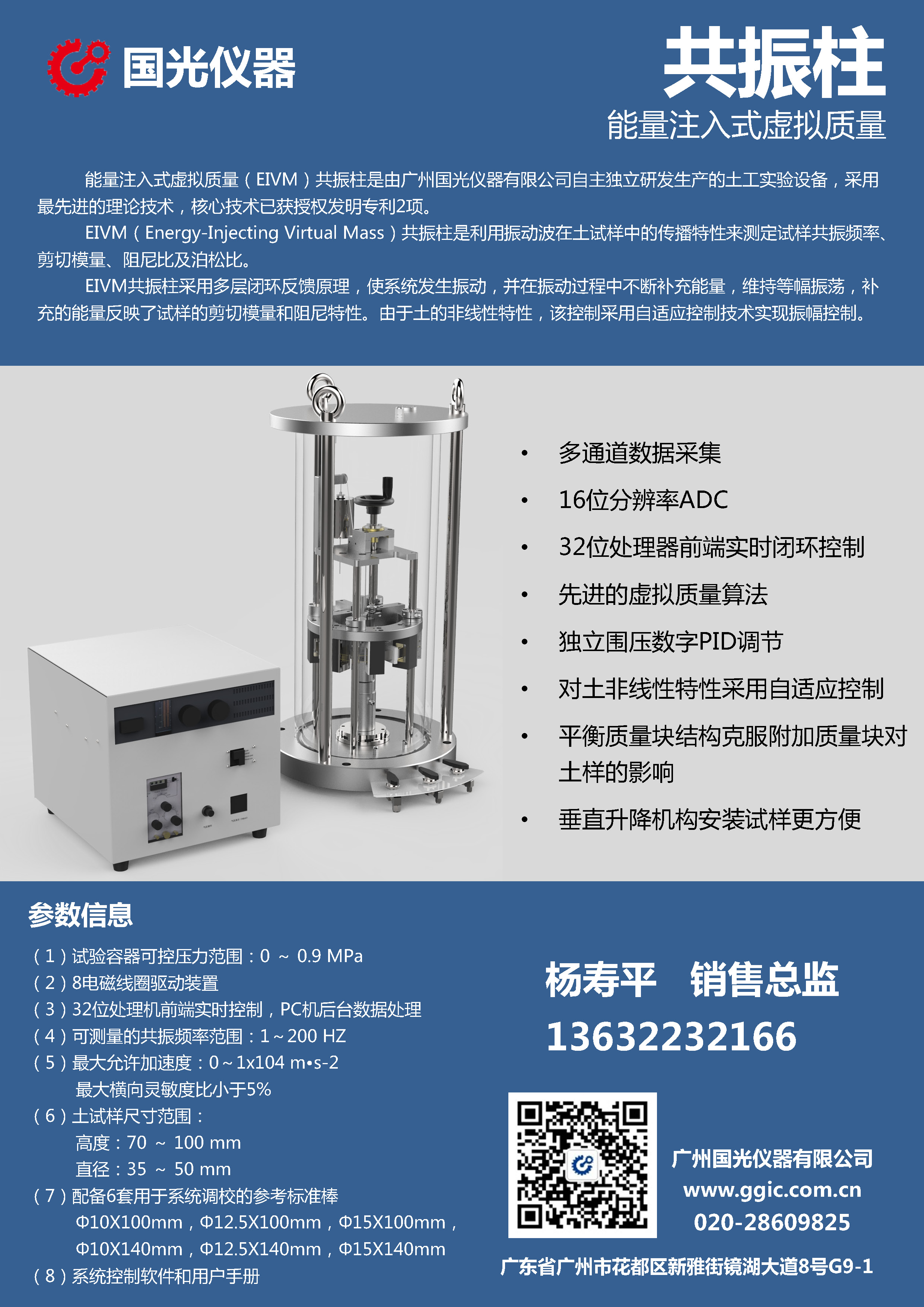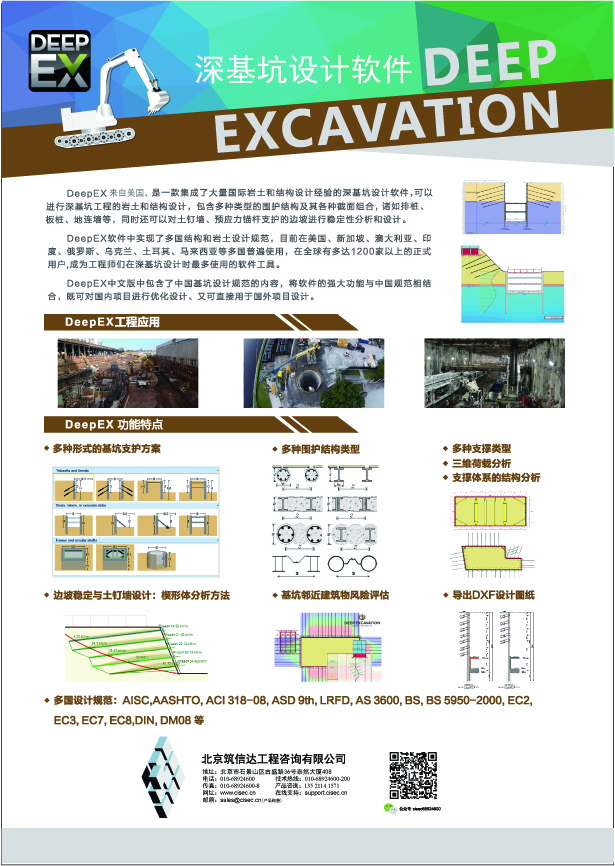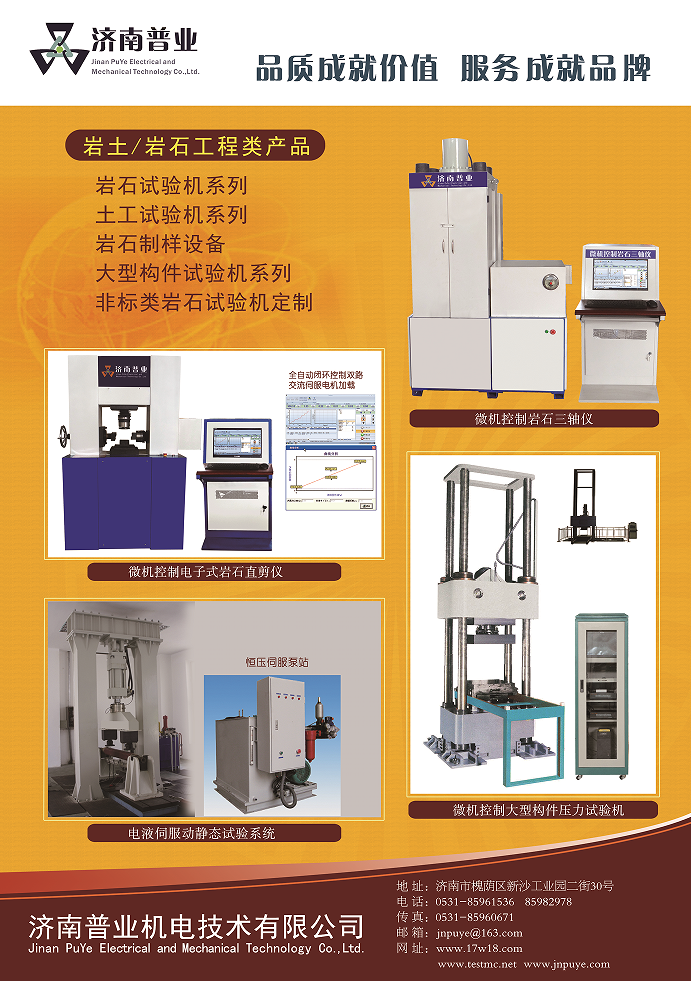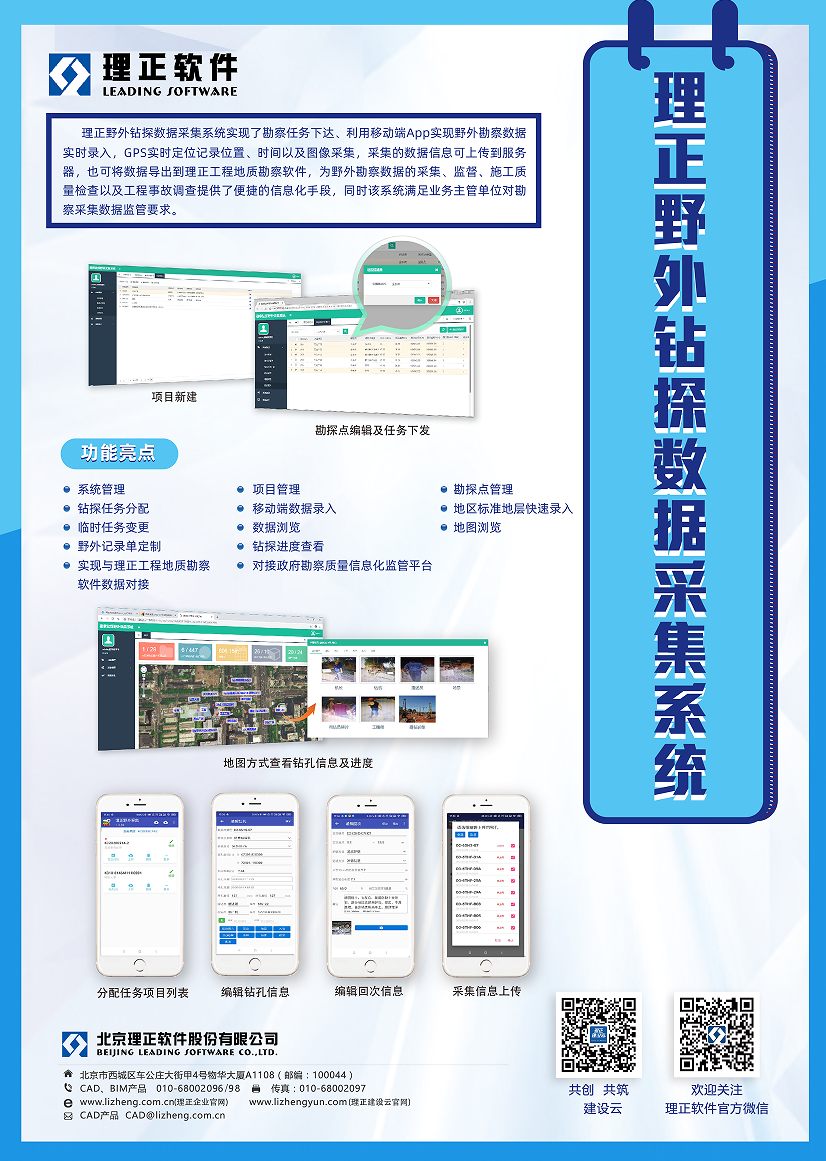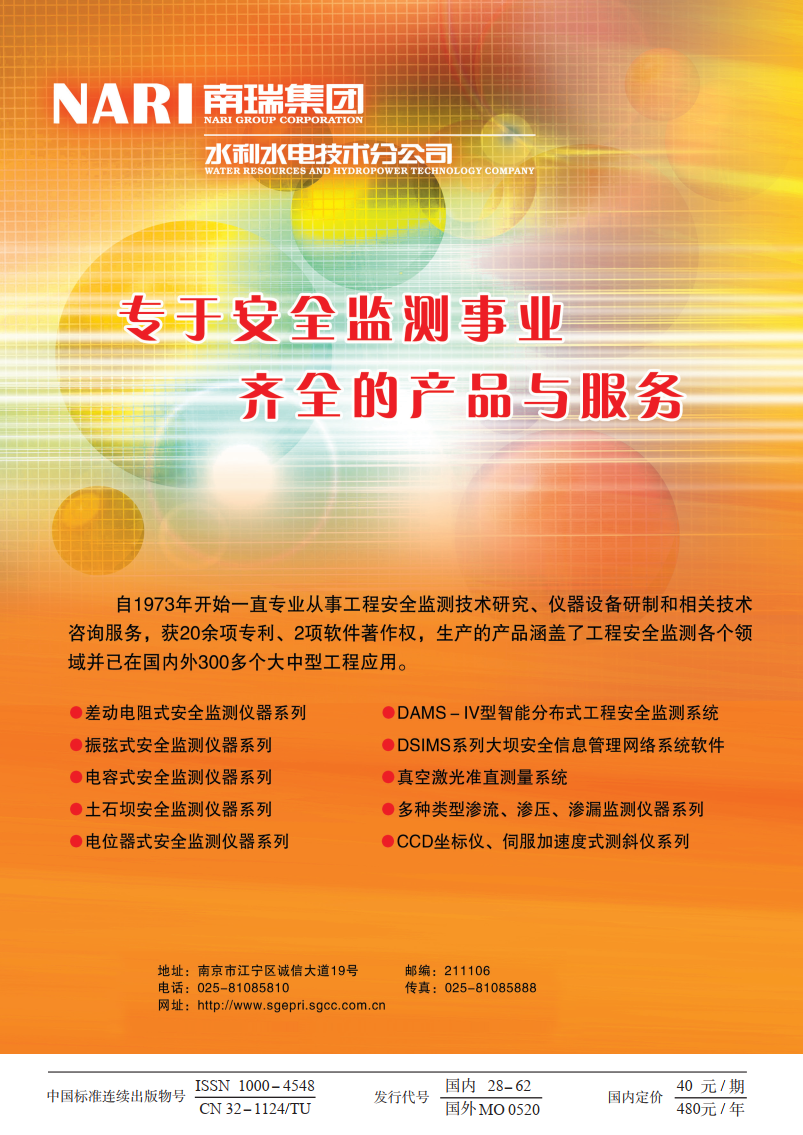Effects of geometrical feature on Forchheimer-flow behavior through rough-walled rock fractures
-
摘要: 为了研究岩体粗糙裂隙几何特征与其非线性渗流特性的相互关系,基于裂隙面分形特性提出了三维粗糙裂隙的几何结构表征模型,通过直接求解N-S(Navier-Stokes)方程,研究了不同开度均值、标准差和分形维数对岩体裂隙Forchheimer型渗流特性的影响规律,验证了Forchheimer方程描述流量与压力梯度非线性关系的有效性。研究结果表明:当流量较小时,随着裂隙开度均值减小、标准差增大,线性系数逐渐增大即水力开度逐渐减小,渗透能力下降,分形维数对其渗透能力的影响较小,并提出了水力开度与开度均值、标准差的经验关系式;当流量较大时,水流流态从线性流向非线性流转变,随着开度均值减小、标准差和分形维数的增大,非线性系数增大,临界雷诺数减小,测得Rec范围为11.16~39.3。Abstract: In order to study the relationship between the geometrical feature and the nonlinear flow properties of rough-walled rock fractures, a numerical model based on the fractal behavior is proposed to characterize the three-dimensional geometry of rough-walled fractures. By solving the N-S (Navier-Stokes) equation directly, the effects of mean aperture, standard deviation of aperture and different fractal dimensions on the Forchheimer flow characteristics of fractures are investigated. The Forchheimer equation is validated to describe the nonlinear relationship between the flow rate and the pressure gradient. The results show that with the lower flow rate, the linear coefficient increases and the hydraulic aperture decreases with the decreasing mean aperture and increasing standard deviation of the aperture, thus the empirical relation for the hydraulic aperture, the mean aperture and the standard deviation of aperture is put forward, while the effects of the fractal dimension almost can be ignored. On the contrary, with larger flow rate, for the flow pattern changing from linear to nonlinear flow, as the mean aperture decreases and the standard deviation of aperture and the fractal dimension increase, the nonlinear coefficient increases, and the critical Reynolds number decreases, with the range of Rec being 11.16~39.3.
-
Keywords:
- rock fracture /
- geometrical feature /
- flow property /
- fractal theory
-
0. 引言
位于寒冷地区的水利工程,地基易受极端低温影响而发生冻胀现象,进而造成对水工建筑物结构的破坏。寒区工程超重力试验平台是利用离心力场模拟超重力场,具有克服小比尺模型的应力差异过大,避免了原位试验复杂耗时的优势,且具备热交换、干/湿环境模拟的功能,是开展寒区水利工程模型试验的重要设备。采用该设备进行寒区工程地基冻胀问题的模拟研究时,模型上方的热交换系统可在一定时间内持续为模型提供冷/热边界,利用热交换系统与模型表面间的之间的空气夹层上下表面温差进行热交换。
开展超重力场下寒区模型试验时,试验设计需了解土体与热交换系统间夹层空腔温度变化。而对空气夹层的换热过程可简化为不同尺寸的空腔及土体的耦合对流换热问题。对于空腔结构内部重力导致的对流问题,石峰等[1-2]研究了矩形腔体中Rayleigh-Benard对流结构,Ning等[3]研究了具有水平流的流体对流的周期行为问题,胡宇鹏等[4]研究了腔体内对流的稳定性问题,传统对此类的问题研究以常重力状态下为主[5-7],对于超重力环境对低温边界下空气夹层-结构对流换热问题研究较少。由于土工模型箱内空气夹层换热过程较为复杂,易受到离心机工作状态的影响,获得超重力对低温对流换热的影响规律是设计试验面临的挑战问题。
本文基于数值模拟开展土体-夹层在超重力条件下对流换热仿真,通过分析土体界面的温度变化以及空腔内换热过程,获得模型表面温度随时间的变化规律,以及空腔内的温度场分布,获得了对换热过程对流、传导相关无量纲数变化的认识,可为开展寒区土体模拟试验提供参考。
1. 夹层传热计算模型
寒区工程超重力试验设备可简化描述为封闭空腔内自然对流传热的物理模型:模型箱内盛放一土体模型,此时模型加速度为Ng(常重力的倍数),方向由离心机主轴指向转臂。热交换板为冷表面,初始温度为;模型表面为光滑平面(热面),初始温度为;模型表面与模型箱下表面的距离为L(夹层间隙厚度),该距离内形成一矩形密闭空腔。超重力场下的密闭空腔换热模型简化如图 1所示。
图 1中土体除上表面外均为绝热,空气夹层上表面为冷边界,土体与夹层界面通过对流及热传导进行热交换。可知空腔内流动包含两种运动:沿固壁的边界层运动以及围绕空腔中心的旋转运动,后者具有典型的Rayleigh-Benard(简称RB)对流的特征。RB对流是研究非平衡开放系统中对流运动的稳定性、时空结构、涡环(又称斑图)形成及非线性动力学特性的典型模型之一[1-4],指在一个封闭的空腔内,其上表面温度恒定,下表面加热,由于底部流体被加热膨胀,相对于上部温度较低的流体其密度较小,下部流体上升,在上升中接触其他流体部分时消耗能量,温度变低密度变大。当底部温度继续升高,某些底部流体的温度足够大,密度足够小,能够上升到顶部而能量不至于全部耗散,从而形成温度差导致腔体内流体运动的流动现象[6]。需要指出的是,存在临界瑞利数(Ra),当空腔内局部Ra高于临界值时,才会出现RB对流[5-7],如图 3所示,否则仅为热传导状态。
该物理问题与常重力场下的Rayleigh-Benard对流相似,仅重力加速度不同。在Boussinesq近似假设(认为浮力诱导的流体运动中,当温度足够小时,仅在浮力项中考虑密度变化)下,在Ng重力场下的流体力学基本控制方程如式(1)所示:
(1) 式中U为流体速度场;T为温度场;ρ为空气密度;g为重力加速度;为空气运动黏度;Cp为空气比热;t为时间;为导热系数。由于直接求解物理模型较为复杂,一般采用基于CFD(计算流体动力学)数值方法开展研究。
根据以上分析,模型箱的边界条件可以简化为:矩形方腔左右两侧绝热,上部为空气,下层为土体(密度为1.80 g/cm3,导热系数为2 W/m·℃,热容为4 MJ/m3·℃,热扩散系数为2.5×10-7 m2/s)。问题可简化为在Ng的超重力场下,研究矩形密闭空腔内的温度变化及温度场分布。考虑到空腔温度变化和从土体交换的热量直接相关,土体的热量与体积、质量等参数密切相关,因此建立考虑空气夹层与土体的温度分析模型,以模拟全场温度变化。同时,考虑到模型箱为长方体结构,取二维模型(侧向剖面)以表征真实三维结构,以降低计算量,提高仿真效率。计算模型的边界条件为:土体与夹层界面为换热边界,夹层上表面为-30℃,其它界面均为绝热边界,全场初始温度为10℃;即= -30℃;=10℃,侧壁及底面均为绝热边界。根据试验状态取常重力及两种超重力状态,即Ng =1,10和50;根据土体情况取夹层厚度L =1,10和20 cm;针对两种参数组合共9种工况开展分析。
2. 夹层-土体对流换热分析
2.1 模型表面温度随时间变化
给出不同空气夹层厚度时界面温度在不同Ng值及间隙下随时间变化,如图 2所示。
图 2结果温度变化趋势与文献[8]一致。分析表明:随着Ng增大,界面降温加速,高Ng下降温速率大于低Ng工况,以20 cm为例,1g(常重力)、10g和50g状态下前2×105 s的平均降温速率分别为13.5,15,16.5℃/105 s;随着换热时间变长,降温速度随之降低,换热过程减速;降温速率与Ng并非线性关系:1,10,50g状态下200000~400000 s的平均降温速率分别为3.5,3,2℃/105 s;原因在于随着土体温度变低,土体界面与空气温差变小,导致温差驱动的对流换热的热量变小,导致降温过程随之减缓。
其次,在超重力状态下,随着夹层间隙减小,降温速率提升,小间隙下降温速率大于大间隙:以1 cm为例,1g,10g和50g状态下前2×105 s平均降温速率分别为12.5,15.5,17.5℃/105 s。空气与土体界面的换热热流率随间隙增大而减小,随Ng上升而上升:如10cm间隙时,初始阶段1g,10g和50g状态下,提取界面换热热流分别为78,165,325 W/m2;1 cm间隙时,10g和50g状态下界面热流率分别为520,630 W/m2,大于间隙较大时。界面对流换热系数变化趋势也一致。
需要指出的是,由于模型箱总容积一定,当夹层厚度较大时(20 cm),土体质量较小(总热容小),夹层厚度较小时,土体质量大(总热容大),导致通过对流及热传导将土体温度降低所需热量不同。
2.2 温度场分布特性
提取典型时刻全场温度分布及空腔流动速度,取具有代表性的20 cm空腔厚度和50g工况为例,如图 3所示,图 4给出了典型状态空腔内涡环的状态。
结合数值仿真结果及图 3,4可以看出:①20 cm间隙时,空腔内呈现典型的RB流动特征,形成两个对称的涡环,涡环外部流速较快,内部流速越来越小;出现涡环,超重力使得流动速度变快,1g,10g和50g下涡环中最大速度分别为0.028,0.65,1.02 m/s;在靠近壁面角落部位,会形成小的涡环,随着空腔流场的发展而变化。②10 cm间隙时,不同Ng下均会出现2对涡环;靠近侧边壁面处涡环较细长,中部涡环长宽比趋于1。③1 cm间隙时,1g状态有明显涡环成对出现;10g和50g状态下无明显的涡环发展过程,仅在靠近壁面交角附近出现较小涡环。④局部涡环会随着换热过程而发展。例如,在1 cm工况时,在初始阶段,先在靠近侧边壁面附近形成小的涡环,随之向空腔中部扩展;等到一定程度,涡环发展稳定;随着换热过程继续,涡环消失,仅在壁面附近形成较小的涡流,空腔气体温度随厚度方向变化明显,体现出传热为主的特征。涡环的稳定分布与流场速度、压力及界面换热系数、温度等直接相关。
2.3 空气夹层换热规律
常用Nu数(努塞尔数)和Ra数(瑞利数)描述换热过程中的参数变化[8],Nu数表征换热系统从流场中吸热的强弱,Ra数表征流场中自然对流的强弱。温度在空气和土体界面上并非完全均匀分布,因此界面上同一时刻对流换热系数、Nu数等并非均匀分布,计算时取界面中点数据。给出土体与空气界面上Nu数随时间的变化如图 5所示。
不同间隙及Ng下,Nu数均随时间降低,在夹层流场启动阶段,Nu数变化较大,表示初始状态流场对流换热较为显著,后续慢慢稳定降低;说明起始阶段(温差最大时刻)换热系统工作效率较高。
3. 结论
通过建立超重力下模型箱土体夹层换热模型,分析了不同厚度及Ng对换热过程的影响规律,研究获得以下结论:
(1)随着超重力Ng值增大,界面降温加速,高Ng值下降温速率大于低Ng值;随着夹层间隙厚度减小,降温速率提升,小间隙下降温速率大于大间隙。
(2)空气与土体界面的换热热量在一定时刻内随间隙增大而减小,随Ng上升而上升,与夹层空腔中涡环发展有关。
(3)超重力状态会使得传热规律发生变化。涡环的稳定分布与流场速度、压力及界面换热系数、温度等直接相关;20 cm间隙时,空腔内呈现典型的RB流动特征,形成两个对称的涡环,超重力使得流动速度变快;10 cm间隙时,不同Ng值下均会出现2对涡环;靠近侧边壁面处涡环较细长,中部涡环长细比小;1 cm间隙时,1g状态有明显涡环成对出现;高Ng值状态下无明显的涡环发展过程,热量传递主要以传热为主。
(4)不同间隙及Ng值下,Nu数均随时间降低,在流场启动阶段,Nu数变化较大;在不同间隙状态下,随着超重力Ng值变大,界面对流换热降低。
-
表 1 网格无关性分析
Table 1 Analysis of grid independence
单元尺寸/mm 网格数量/104 求解时间 物理内存/GB 结果/Pa 0.250 66.58 8分59秒 4.68 110.92 0.230 80.94 12分28秒 4.86 103.77 0.200 113.52 19分22秒 5.82 95.112 0.180 143.68 34分23秒 6.09 90.053 0.175 152.47 59分10秒 6.34 89.12 0.170 164.69 90分46秒 6.30 87.509 0.160 189.04 165分22秒 6.56 86.55 表 2 线性系数A和非线性系数B
Table 2 Values of linear coefficient A and nonlinear coefficient B
开度均值/mm 标准差/mm D=2.1 D=2.2 D=2.3 D=2.4 D=2.5 A B A B A B A B A B 0.70 0.09 7.9881 0.8631 8.0081 0.9063 7.9850 0.9245 8.0201 1.0886 7.9810 1.1948 0.12 8.1592 1.0319 8.1831 1.0395 8.3549 1.1386 8.1942 1.2533 8.3403 1.2722 0.15 8.3122 1.0427 8.5025 1.0754 8.4001 1.1766 8.4931 1.3884 8.6016 1.5342 0.18 8.7742 1.1996 8.7086 1.2634 8.7903 1.5410 8.8561 1.5730 9.0268 1.8872 0.21 9.3183 1.3650 9.0407 1.9623 8.9406 2.3172 9.0750 2.5956 9.6689 2.6839 0.75 0.09 6.5077 0.6359 6.5082 0.6476 6.5181 0.6737 6.5301 0.6708 6.5595 0.7189 0.12 6.6114 0.7013 6.5928 0.8232 6.6005 0.8222 6.6883 0.8853 6.6451 0.9675 0.15 6.7716 0.7821 6.7630 0.8663 6.8099 0.9138 6.8346 1.0207 6.9403 1.0424 0.18 7.0165 0.9409 7.0303 0.9758 7.0799 1.1197 7.1480 1.1841 7.2179 1.3674 0.21 7.3457 1.0103 7.3609 1.1502 7.3260 1.3037 7.4201 1.4182 7.6003 1.6886 0.80 0.09 5.4034 0.4757 5.4458 0.4823 5.3659 0.5485 5.3438 0.5740 5.3992 0.5922 0.12 5.4444 0.5018 5.4855 0.5276 5.4405 0.5953 5.4694 0.6206 5.5305 0.6438 0.15 5.5328 0.6351 5.5351 0.6505 5.5571 0.6903 5.6169 0.7380 5.6962 0.7999 0.18 5.7546 0.6519 5.6861 0.7334 5.7750 0.8330 5.7980 0.8662 5.9162 0.9422 0.21 5.9371 0.7400 5.9073 0.7968 5.9457 0.9684 6.0859 1.0399 6.1693 1.2410 0.85 0.09 4.4743 0.3796 4.4783 0.3949 4.4466 0.4224 4.5273 0.4204 4.4770 0.4775 0.12 4.5770 0.3917 4.6725 0.4285 4.6931 0.4406 4.6128 0.4738 4.5644 0.4814 0.15 4.6240 0.4168 4.6540 0.4926 4.6321 0.5152 4.7123 0.5528 4.7514 0.5866 0.18 4.7719 0.4638 4.7216 0.5441 4.7519 0.6109 4.8300 0.6132 4.9185 0.6987 0.21 4.8836 0.5452 4.8808 0.5772 4.9173 0.6806 4.9958 0.7364 5.1056 0.9202 0.90 0.09 3.7816 0.2981 3.7857 0.2999 3.7941 0.2996 3.8015 0.3186 3.7873 0.3434 0.12 3.8605 0.3122 3.8300 0.3352 3.8388 0.3376 3.8633 0.3639 3.9077 0.3656 0.15 3.9244 0.3393 3.9207 0.3507 3.9756 0.3782 3.9765 0.4225 4.0178 0.4993 0.18 3.9775 0.3738 3.9765 0.3965 4.0512 0.4002 4.0533 0.4836 4.1303 0.5552 0.21 4.0892 0.4038 4.0805 0.4779 4.1200 0.5300 4.2182 0.5797 4.3172 0.6987 注: A=108·kg/s1/m5;B=1014·kg/m8。表 3 不同开度均值拟合参数对比
Table 3 Comparison of fitting parameters with different apertures
开度均值/mm m n c R2 0.70 1251 -2294 -78.76 197.5 0.8792 0.75 846.2 -1563 -60.45 164.2 0.9763 0.80 603.1 -1084 -34.12 102.4 0.9580 0.85 536.7 -1015 -32.87 100.9 0.9372 0.90 534.5 -1003 -29.43 97.9 0.9432 表 4 岩体裂隙渗流研究中关于临界雷诺数的文献总结
Table 4 Summary of critical Reynolds number of flow in rock fractures in existing literatures
-
[1] SNOW D T. A parallel plate model of fractured permeable media[D]. Berkeley: University of California of Berkeley, 1965.
[2] ZIMMERMAN R W, AL-YAARUBI A, PAIN C C, et al. Non-linear regimes of fluid flow in rock fractures[J]. International Journal of Rock Mechanics & Mining Sciences, 2004, 41(3): 163-169.
[3] ZHANG Z Y, NEMCIK J. Fluid flow regimes and nonlinear flow characteristics in deformable rock fractures[J]. Journal of Hydrology, 2013, 477(16): 139-151.
[4] 姚池, 邵玉龙, 杨建华, 等. 非线性渗流对裂隙岩体渗流传热过程的影响[J]. 岩土工程学报, 2020, 42(6): 1050-1058. https://www.cnki.com.cn/Article/CJFDTOTAL-YTGC202006011.htm YAO Chi, SHAO Yu-long, YANG Jian-hua, et al. Effect of nonlinear seepage on flow and heat transfer process of fractured rocks[J]. Chinese Journal of Geotechnical Engineering, 2020, 42(6): 1050-1058. (in Chinese) https://www.cnki.com.cn/Article/CJFDTOTAL-YTGC202006011.htm
[5] 张戈, 田园, 李英骏. 不同JRC粗糙单裂隙的渗流机理数值模拟研究[J]. 中国科学:物理学 力学 天文学, 2019, 49(1): 30-39. https://www.cnki.com.cn/Article/CJFDTOTAL-JGXK201901003.htm ZHANG Ge, TIAN Yuan, LI Ying-jun. Numerical study on the mechanism of fluid flow through single rough fractures with different JRC[J]. Scientia Sinica (Physica, Mechanica & Astronomica), 2019, 49(1): 30-39. (in Chinese) https://www.cnki.com.cn/Article/CJFDTOTAL-JGXK201901003.htm
[6] CHEN Y F, ZHOU J Q, HU S H, et al. Evaluation of Forchheimer equation coefficients for non-Darcy flow in deformable rough-walled fractures[J]. Journal of Hydrology, 2015, 529: 993-1006. doi: 10.1016/j.jhydrol.2015.09.021
[7] YIN Q, MA G W, JING H W, et al. Hydraulic properties of 3D rough-walled fractures during shearing: an experimental study[J]. Journal of Hydrology, 2017, 555: 169-184. doi: 10.1016/j.jhydrol.2017.10.019
[8] 肖维民, 夏才初, 王伟, 等. 考虑接触面积影响的粗糙节理渗流分析[J]. 岩土力学, 2013, 34(7): 1913-1922. doi: 10.16285/j.rsm.2013.07.022 XIAO Wei-min, XIA Cai-chu, WANG Wei, et al. Analysis of fluid flow through a rough joint considering effect of contact area[J]. Rock and Soil Mechanics, 2013, 34(7): 1913-1922. (in Chinese) doi: 10.16285/j.rsm.2013.07.022
[9] TSANG Y W. The effect of tortuosity on fluid flow through a single fracture[J]. Water Resources Research, 1984, 20(9): 1209-1215. doi: 10.1029/WR020i009p01209
[10] 熊峰, 孙昊, 姜清辉, 等. 粗糙岩石裂隙低速非线性渗流模型及试验验证[J]. 岩土力学, 2018, 39(9): 3294-3302, 3312. https://www.cnki.com.cn/Article/CJFDTOTAL-YTLX201809025.htm XIONG Feng, SUN Hao, JIANG Qing-hui, et al. Theoretical model and experimental verification on non-linear flow at low velocity through rough-walled rock fracture[J]. Rock and Soil Mechanics, 2018, 39(9): 3294-3302, 3312. (in Chinese) https://www.cnki.com.cn/Article/CJFDTOTAL-YTLX201809025.htm
[11] CHEN Y D, LIAN H J, LIANG W G, et al. The influence of fracture geometry variation on non-Darcy flow in fractures under confining stresses[J]. International Journal of Rock Mechanics and Mining Sciences, 2019, 113: 59-71. doi: 10.1016/j.ijrmms.2018.11.017
[12] WANG C S, JIANG Y J, LIU R C, et al. Experimental study of the nonlinear flow characteristics of fluid in 3D rough-walled fractures during shear process[J]. Rock Mechanics and Rock Engineering, 2020, 53(6): 2581-2604. doi: 10.1007/s00603-020-02068-5
[13] 谢和平. 分形几何及其在岩土力学中的应用[J]. 岩土工程学报, 1992, 14(1): 14-24. doi: 10.3321/j.issn:1000-4548.1992.01.002 XIE He-ping. Fractal geometry and its application to rock and soil materials[J]. Chinese Journal of Geotechnical Engineering, 1992, 14(1): 14-24. (in Chinese) doi: 10.3321/j.issn:1000-4548.1992.01.002
[14] BROWN S R. Fluid flow through rock joints: The effect of surface roughness[J]. Journal of Geophysical Research: Solid Earth, 1987, 92(B2): 1337-1347. doi: 10.1029/JB092iB02p01337
[15] LIU R C, HE M, HUANG N, et al. Three-dimensional double-rough-walled modeling of fluid flow through self-affine shear fractures[J]. Journal of Rock Mechanics and Geotechnical Engineering, 2020, 12(1): 41-49. doi: 10.1016/j.jrmge.2019.09.002
[16] 李毅. 岩石裂隙的非饱和渗透特性及其演化规律研究[J]. 岩土力学, 2016, 37(8): 2254-2262. https://www.cnki.com.cn/Article/CJFDTOTAL-YTLX201608017.htm LI Yi. Unsaturated hydraulic properties of rock fractures and their variation law[J]. Rock and Soil Mechanics, 2016, 37(8): 2254-2262. (in Chinese) https://www.cnki.com.cn/Article/CJFDTOTAL-YTLX201608017.htm
[17] YE Z Y, LIU H H, JIANG Q H, et al. Two-phase flow properties in aperture-based fractures under normal deformation conditions: analytical approach and numerical simulation[J]. Journal of Hydrology, 2017, 545: 72-87. doi: 10.1016/j.jhydrol.2016.12.017
[18] WANG J, NARASIMHAN T, SCHOLZ C. Aperture correlation of a fractal fracture[J]. Journal of Geophysical Research, 1988, 93: 2216-2224. doi: 10.1029/JB093iB03p02216
[19] ZENG Z W, GRIGG R. A criterion for non-darcy flow in porous media[J]. Transport in Porous Media, 2006, 63(1): 57-69. doi: 10.1007/s11242-005-2720-3
[20] JAVADI M, SHARIFZADEH M, SHAHRIAR K, et al. Critical Reynolds number for nonlinear flow through rough-walled fractures: the role of shear processes[J]. Water Resources Research, 2014, 50(2): 1789-1804. doi: 10.1002/2013WR014610
[21] ZOU L C, JING L R, CVETKOVIC V. Shear-enhanced nonlinear flow in rough-walled rock fractures[J]. International Journal of Rock Mechanics and Mining Sciences, 2017, 97: 33-45. doi: 10.1016/j.ijrmms.2017.06.001
[22] WANG Z H, XU C S, DOWD P, et al. A nonlinear version of the Reynolds equation for flow in rock fractures with complex void geometries[J]. Water Resources Research, 2020, 56(2): 1-12.
[23] 王志良, 申林方, 徐则民, 等. 岩体裂隙面粗糙度对其渗流特性的影响研究[J]. 岩土工程学报, 2016, 38(7): 1262-1268. https://www.cnki.com.cn/Article/CJFDTOTAL-YTGC201607013.htm WANG Zhi-liang, SHEN Lin-fang, XU Ze-min, et al. Influence of roughness of rock fracture on seepage characteristics[J]. Chinese Journal of Geotechnical Engineering, 2016, 38(7): 1262-1268. (in Chinese) https://www.cnki.com.cn/Article/CJFDTOTAL-YTGC201607013.htm
[24] KONZUK J S, KUEPER B H. Evaluation of cubic law based models describing single-phase flow through a rough-walled fracture[J]. Water Resources Research, 2004, 40(2): W02402.
[25] CHEN Y F, HU S H, HU R, et al. Estimating hydraulic conductivity of fractured rocks from high-pressure packer tests with an Izbash's law-based empirical model[J]. Water Resources Research, 2015, 51(4): 2096-2118. doi: 10.1002/2014WR016458
[26] QIAN J Z, ZHAN H B, LUO S H, et al. Experimental evidence of scale-dependent hydraulic conductivity for fully developed turbulent flow in a single fracture[J]. Journal of Hydrology, 2007, 339(3/4): 206-215.
[27] RONG G, YANG J, CHENG L, et al. Laboratory investigation of nonlinear flow characteristics in rough fractures during shear process[J]. Journal of Hydrology, 2016, 541: 1385-1394. doi: 10.1016/j.jhydrol.2016.08.043




 下载:
下载:













